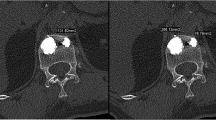Abstract
Purpose
The aim of the study was to evaluate the efficacy of an injectable and partly absorbable calcium bone cement (CERAMENT™, Bone Support, Sweden) in the treatment of osteoporotic or traumatic vertebral fractures by percutaneous vertebroplasty.
Methods
From March 2009 to October 2010 an open, prospective study in two centres was performed. 33 patients with symptomatic vertebral fractures were enrolled. Patients were included based on evaluation by X-ray, CT, and MRI. Clinical evaluation by Visual Analogue Scale (VAS, 0–10) and Oswestry Disability index test (ODI, 0–100 %) was performed before the operation as well as 1, 6 and 12 months after the procedure. Radiology assessment post-procedure was carried out by X-ray, CT, and MRI at 1, 6 and 12 months post-op. Intake of analgesic medications pre- and post-procedure was monitored.
Results
66 vertebral bodies underwent percutaneous vertebroplasty. VAS score demonstrated a significant decrease from 8.61 (SD 19.8) pre-operatively to 2.48 (SD 2.36) at 1 month. The score was 2.76 (SD 2.68) at 6 months and 1.36 (SD 1.33) at the latest follow up. ODI score dropped significantly from 58.86 pre-op to 26.94 at 6 months and further down to 7.61 at 12 months. No re-fractures or adjacent level fractures were reported.
Conclusion
Data show that CERAMENT can be a substitute of PMMA in the treatment of osteoporotic and traumatic vertebral fractures, especially in young patients.












Similar content being viewed by others
References
Calvo-Fernandez T, Parra J, Fernandez-Gutierrez M, Vazquez-Lasa B, Lopez-Bravo A, Collia F, Perez de la Cruz MA, San RJ (2010) Biocompatibility of alendronate-loaded acrylic cement for vertebroplasty. Eur Cell Mater 20:260–273
Rauschmann M, Vogl T, Verheyden A, Pflugmacher R, Werba T, Schmidt S, Hierholzer J (2010) Bioceramic vertebral augmentation with a calcium sulphate/hydroxyapatite composite (Cerament SpineSupport): in vertebral compression fractures due to osteoporosis. Eur Spine J 19:887–892
Schmelzer-Schmied N, Cartens C, Meeder PJ, Dafonseca K (2009) Comparison of kyphoplasty with use of a calcium phosphate cement and non-operative therapy in patients with traumatic non-osteoporotic vertebral fractures. Eur Spine J 18:624–629
Zhu XS, Zhang ZM, Mao HQ, Geng DC, Zou J, Wang GL, Zhang ZG, Wang JH, Chen L, Yang HL (2011) A novel sheep vertebral bone defect model for injectable bioactive vertebral augmentation materials. J Mater Sci Mater Med 22:159–164
Hernandez L, Parra J, Vazquez B, Bravo AL, Collia F, Goni I, Gurruchaga M, San RJ (2009) Injectable acrylic bone cements for vertebroplasty based on a radiopaque hydroxyapatite. Bioactivity and biocompatibility. J Biomed Mater Res B Appl Biomater 88:103–114
Folman Y, Shabat S (2011) A comparison of two new technologies for percutaneous vertebral augmentation: confidence vertebroplastys. Sky kyphoplasty. BMC Musculoskelet Disord 12:206. doi:10.1186/1471-2474-12-206 (published online 2011 September 22)
Chen LH, Lai PL, Chen WJ (2011) Current status of vertebroplasty for osteoporotic compression fracture. Chang Gung Med J 34(4):352–359 (July–August)
Belkoff SM, Mathis JM, Jasper LE (2002) Ex vivo biomechanical comparison of hydroxyapatite and polymethylmethacrylate cements for use with vertebroplasty. Am J Neuroradiol 23:1647–1651
Lim TH, Brebach GT, Renner SM, Kim WJ, Kim JG, Lee RE, Andersson GB, An HS (2002) Biomechanical evaluation of an injectable calcium phosphate cement for vertebroplasty. Spine (Phila Pa 1976) 27:1297–1302
Robinson Y, Heyde CE, Försth P, Olerud C (2011) Kyphoplasty in osteoporotic vertebral compression fractures—guidelines and technical considerations. J Orthop Surg Res 6:43. doi:10.1186/1749-799X-6-43 (published online 2011 August 19)
Al-Nakshabandi NA (2011) Percutaneous vertebroplasty complications. Ann Saudi Med 31(3):294–297. doi:10.4103/0256-4947.81542 (May–June)
Grafe IA, Baier M, Noldge G, Weiss C, Da FK, Hillmeier J, Libicher M, Rudofsky G, Metzner C, Nawroth P, Meeder PJ, Kasperk C (2008) Calcium–phosphate and polymethylmethacrylate cement in long-term outcome after kyphoplasty of painful osteoporotic vertebral fractures. Spine (Phila Pa 1976) 33:1284–1290
Maestretti G, Cremer C, Otten P, Jakob RP (2007) Prospective study of standalone balloon kyphoplasty with calcium phosphate cement augmentation in traumatic fractures. Eur Spine J 16:601–610
Burguera EF, Xu HH, Sun L (2008) Injectable calcium phosphate cement: effects of powder-to-liquid ratio and needle size. J Biomed Mater Res B Appl Biomater 84:493–502
Ryu KS, Shim JH, Heo HY, Park CK (2010) Therapeutic efficacy of injectable calcium phosphate cement in osteoporotic vertebral compression fractures: prospective nonrandomized controlled study at 6-month follow-up. World Neurosurg 73:408–411
Masala S, Nano G, Marcia S et al (2011) Osteoporotic vertebral compression fractures augmentation by injectable partly resorbable ceramic bone substitute (Cerament™ Spine Support): a prospective nonrandomized study. Neuroradiology. doi:10.1007/s00234-011-0940-5
Conflict of interest
None.
Author information
Authors and Affiliations
Corresponding author
Rights and permissions
About this article
Cite this article
Marcia, S., Boi, C., Dragani, M. et al. Effectiveness of a bone substitute (CERAMENT™) as an alternative to PMMA in percutaneous vertebroplasty: 1-year follow-up on clinical outcome. Eur Spine J 21 (Suppl 1), 112–118 (2012). https://doi.org/10.1007/s00586-012-2228-9
Received:
Accepted:
Published:
Issue Date:
DOI: https://doi.org/10.1007/s00586-012-2228-9




